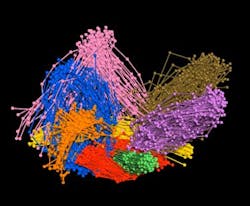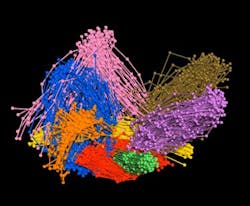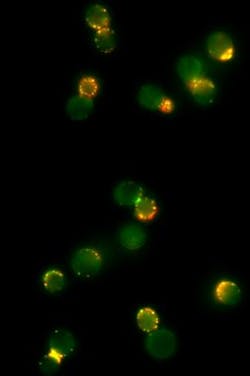Super-resolution microscopy helps enable 3D observation of protein complexes in live cells
A combination approach that includes super-resolution microscopy has allowed scientists at the Institute for Research in Biomedicine (IRB Barcelona; Spain) and collaborators to observe protein complexes (the structures responsible for performing cell functions) in living cells and in 3D.
Related: Laser microscopy helps track key component of cell division
Currently, biologists who study the function of protein complexes isolate them in test tubes, and then apply in vitro techniques that allow them to observe their structure up to the atomic level. Alternatively, they use techniques that allow the analysis of these complexes within a living cell, but give little structural information. In the research team's study, they have managed to directly observe the structure of the protein machinery in living cells while it is executing its function.
The researchers' method brings together super-resolution microscopy, cell engineering, and computational modeling, which allows the team to observe protein complexes with 5 nm precision—a resolution "four times better than that offered by super-resolution and that allows us to perform cell biology studies that were previously unfeasible," explains Oriol Gallego, an IRB Barcelona researcher and coordinator of the group that performed the study, which also involved PhD student Irene Pazos.
The researchers genetically modified cells to build artificial supports inside, onto which they can anchor protein complexes. These supports are designed in such a way as to allow them to regulate the angle from which the immobilized protein complexes are viewed. After, to determine the 3D structure of the protein complex, they use super-resolution techniques to measure the distances between different components and then integrate them in a process similar to that used by GPS.
Gallego has used this method to study exocytosis, a mechanism that the cell uses to communicate with the cell exterior. For instance, neurons communicate with each other by releasing neurotransmitters via exocytosis. The study has allowed the scientists to reveal the entire structure of a key protein complex in exocytosis: "We now know how this machinery, which is formed by eight proteins, works and what each protein is important for. This knowledge will help us to better understand the involvement of exocytosis in cancer and metastasis—processes in which this nanomachinery is altered," Gallego explains.
An understanding of how protein complexes carry out their cell functions has biomedical implications since alterations in the inner workings can lead to the development of diseases. With this new strategy in hand, it will be possible to study cellular protein machinery in health and in disease. For example, it would be possible to see how viruses and bacteria use protein complexes during infection, and to better understand the defects in complexes that lead to diseases to enable design of new therapeutic strategies that reverse them.
The technique can be used on relatively large complexes. "Being able to see protein complexes measuring 5 nm is a great achievement, but there is still a long way to go to be able to observe the inside of the cell at the atomic scale that in vitro techniques would allow," Gallego says. "But, I think that the future lies in integrating various methods and combining the power of each one."
The collaboration involved researchers at the University of Geneva (Switzerland) and the Centro Andaluz de Biología del Desarrollo (Seville, Spain).
Full details of the work appear in the journal Cell; for more information, please visit http://dx.doi.org/10.1016/j.cell.2017.01.004.



